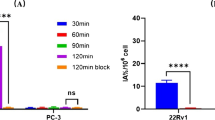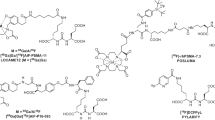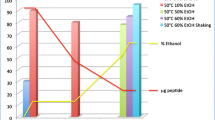Abstract
Facile automatic production is important for the application of prostate-specific membrane antigen (PSMA) tracers in clinical practice. We developed a new 18F-AlF-labelled PSMA probe—18F-AlF-PSMA-NF—and explore its automated production method and potential value in clinical settings. 18F-AlF-PSMA-NF was prepared using an automated method with dimethylformamide (DMF) as the solvent in a positron emission tomography (PET)-MF-2 V-IT-I synthesizer. Tracer characteristics were examined both in vitro and in vivo. Micro-PET/computed tomography (CT) was performed to investigate the utility of 18F-AlF-PSMA-NF for imaging PSMA-positive tumours in vivo. 18F-AlF-PSMA-NF was prepared automatically within 35 min with a non-attenuation correction yield of 37.9 ± 11.2%. The tracer was hydrophilic, had a high affinity for PSMA (Kd = 2.58 ± 0.81 nM), and showed stability in both in vitro and in vivo conditions. In the cellular experiments, 18F-AlF-PSMA-NF uptake in PSMA-positive LNCaP cells was significantly higher than that in PSMA-negative PC-3 cells (P < 0.001), and could be blocked by excess ZJ-43—a PSMA inhibitor (P < 0.001). LNCaP tumours were clearly visualized by 18F-AlF-PSMA-NF on micro-PET/CT, with a high level of uptake (13.72 ± 2.01 percent injected dose per gram of tissue [%ID/g]) and high tumour/muscle ratio (close to 50:1). The PSMA-positive LNCaP tumours had a significantly higher uptake than PSMA-negative PC-3 tumours (13.72 ± 2.01%ID/g vs. 1.07 ± 0.48%ID/g, t = 10.382, P < 0.001), and could be blocked by ZJ-43 (13.72 ± 2.01%ID/g vs. 2.77 ± 1.44%ID/g, t = 8.14, P < 0.001). A new 18F-AlF-labelled PSMA probe—18F-AlF-PSMA-NF—was successfully developed and can be prepared automatically. It has the biological characteristics resembling that of a PSMA-based probe and can potentially be used in clinical settings.








Similar content being viewed by others
Availability of data and material
The datasets used or analysed during the current study are available from the corresponding author on reasonable request.
References
Afshar-Oromieh A, Babich JW, Kratochwil C, Giesel FL, Eisenhut M, Kopka K, Haberkorn U (2016) The rise of PSMA ligands for diagnosis and therapy of prostate cancer. J Nucl Med 57(Suppl 3):79S-89S
Afshar-Oromieh A, Holland-Letz T, Giesel FL, Kratochwil C, Mier W, Haufe S, Debus N, Eder M, Eisenhut M, Schäfer M, Neels O, Hohenfellner M, Kopka K, Kauczor H, Debus J, Haberkorn U (2017) Diagnostic performance of 68Ga-PSMA-11 (HBED-CC) PET/CT in patients with recurrent prostate cancer: evaluation in 1007 patients. Eur J Nucl Med Mol I 44:1258–1268
Baccala A, Sercia L, Li J, Heston W, Zhou M (2007) Expression of prostate-specific membrane antigen in tumor-associated neovasculature of renal neoplasms. Urology 70:385–390
Bray F, Ferlay J, Soerjomataram I, Siegel RL, Torre LA, Jemal A (2018) Global cancer statistics 2018: GLOBOCAN estimates of incidence and mortality worldwide for 36 cancers in 185 countries. CA Cancer J Clin 68:394–424
Carter RE, Feldman AR, Coyle JT (1996) Prostate-specific membrane antigen is a hydrolase with substrate and pharmacologic characteristics of a neuropeptidase. P Natl Acad Sci USA 93:749–753
Dietlein F, Hohberg M, Kobe C, Zlatopolskiy BD, Krapf P, Endepols H, Täger P, Hammes J, Heidenreich A, Neumaier B, Drzezga A, Dietlein M (2020) An18 F-labeled PSMA ligand for PET/CT of prostate cancer: first-in-humans observational study and clinical experience with 18F-JK-PSMA-7 during the first year of application. J Nucl Med 61:202–209
Eiber M, Maurer T, Souvatzoglou M, Beer AJ, Ruffani A, Haller B, Graner F-P, Kubler H, HaberhornU EM, Wester H-J, Gschwend JE, Schwaiger M (2015) Evaluation of hybrid (68)Ga-PSMA ligand PET/CT in 248 patients with biochemical recurrence after radical prostatectomy. J Nucl Med 56:668–674
Gai Y, Yuan L, Sun L, Li H, Li M, Fang H, Altine B, Liu Q, Zhang Y, Zeng D, Lan X (2020) Comparison of Al18F- and 68Ga-labeled NOTA-PEG4-LLP2A for PET imaging of very late antigen-4 in melanoma. J Biol Inorg Chem 25:99–108
Giesel FL, Will L, Lawal I, Lengana T, Kratochwil C, Vorster M, Neels O, Reyneke F, Haberkon U, Kopka K, Sathekge M (2018) Intraindividual comparison of 18F-PSMA-1007 and18F-DCFPyL PET/CT in the prospective evaluation of patients with newly diagnosed prostate carcinoma: a Pilot study. J Nucl Med 59:1076–1080
Giesel FL, Knorr K, Spohn F, Will L, Maurer T, Flechsig P, Neels O, Schiller K, Amaral H, Weber WA, Haberkorn U, Schwaiger M, Kratochwil C, Choyke P, Kramer V, Kopka K, Eiber M (2019) Detection efficacy of (18)F-PSMA-1007 PET/CT in 251 patients with biochemical recurrence of prostate cancer after radical prostatectomy. J Nucl Med 60:362–368
Huang S, Wu H, Li B, Fu L, Sun P, Wang M, Hu K (2020) Automated radiosynthesis and preclinical evaluation of Al[(18)F]F-NOTA-P-GnRH for PET imaging of GnRH receptor-positive tumors. Nucl Med Biol 82–83:64–71
Kelly J, Amor-Coarasa A, Nikolopoulou A, Kim D, Williams CJ, Ponnala S, Babich JW (2017) Synthesis and pre-clinical evaluation of a new class of high-affinity (18)F-labeled PSMA ligands for detection of prostate cancer by PET imaging. Eur J Nucl Med Mol Imaging 44:647–661
Kesler M, Levine C, Hershkovitz D, Mishani E, Menachem Y, Lerman H, Zohar Y, Shibolet O, Even-Sapir E (2019) 68 Ga-labeled prostate-specific membrane antigen is a novel PET/CT tracer for imaging of hepatocellular carcinoma: a prospective pilot study. J Nucl Med 60:185–191
Kinoshita Y, Kuratsukuri K, Landas S, Imaida K, Rovito PM Jr, Wang CY, Haas GP (2006) Expression of prostate-specific membrane antigen in normal and malignant human tissues. World J Surg 30:628–636
Kuo H, Lepage ML, Lin K, Pan J, Zhang Z, Liu Z, Pryyma A, Zhang C, Merkens H, Roxin A, Perrin DM, Bénard F (2019) One-step18f-labeling and preclinical evaluation of prostate-specific membrane antigen trifluoroborate probes for cancer imaging. J Nucl Med 60:1160–1166
Li Y, Zhang J, Gu J, Hu K, Huang S, Conti PS, Wu H, Chen K (2020) Radiofluorinated GPC3-binding peptides for PET imaging of hepatocellular carcinoma. Mol Imaging Biol 22:134–143
Liu C, Liu T, Zhang N, Liu Y, Li N, Du P, Yang Y, Liu M, Gong K, Yang X, Zhu H, Yan K, Yang Z (2018) 68Ga-PSMA-617 PET/CT: a promising new technique for predicting risk stratification and metastatic risk of prostate cancer patients. Eur J Nucl Med Mol Imaging 45:1852–1861
Liu T, Liu C, Xu X, Liu F, Guo X, Li N, Wang X, Yang J, Yang X, Zhu H, Yang Z (2019) Preclinical evaluation and pilot clinical study of Al18F-PSMA-BCH for prostate cancer PET imaging. J Nucl Med 60:1284–1292
Lutje S, Franssen GM, Herrmann K, Boerman OC, Rijpkema M, Gotthardt M, Heskamp S (2019) In vitro and in vivo characterization of an (18)F-AlF-labeled PSMA ligand for imaging of PSMA-expressing xenografts. J Nucl Med 60:1017–1022
McBride WJ, D’Souza CA, Sharkey RM, Karacay H, Rossi EA, Chang CH, Goldenberg DM (2020) Improved 18F labeling of peptides with a fluoride-aluminum-chelate complex. Bioconjug Chem 21:1331–1340
Rahbar K, Afshar-Oromieh A, Seifert R, Wagner S, Schafers M, Bogemann M, Weckesser M (2018) Diagnostic performance of (18)F-PSMA-1007 PET/CT in patients with biochemical recurrent prostate cancer. Eur J Nucl Med Mol Imaging 45:2055–2061
Raveenthiran S, Esler R, Yaxley J, Kyle S (2019) The use of 68Ga-PET/CT PSMA in the staging of primary and suspected recurrent renal cell carcinoma. Eur J Nucl Med Mol Imaging 46:2280–2288
Rowe SP, Drzezga A, Neumaier B, Dietlein M, Gorin MA, Zalutsky MR, Pomper MG (2016) Prostate-specific membrane antigen-targeted radiohalogenated PET and therapeutic agents for prostate cancer. J Nucl Med 57(Suppl 3):90S-96S
Sasikumar A, Kashyap R, Joy A, Charan Patro K, Bhattacharya P, Reddy Pilaka VK, Oommen KE, Pillai MRA (2018) Utility of 68Ga-PSMA-11 PET/CT in imaging of glioma-a pilot study. Clin Nucl Med 43:e304–e309
Silver DA, Pellicer I, Fair WR, Heston WD, Cordon-Cardo C (1997) Prostate-specific membrane antigen expression in normal and malignant human tissues. Clin Cancer Res 3:81–85
Zlatopolskiy BD, Endepols H, Krapf P, Guliyev M, Urusova EA, Richarz R, Hohberg M, Dietlein M, Drzezga A, Neumaier B (2019) Discovery of18F-JK-PSMA-7, a PET probe for the detection of small PSMA-positive lesions. J Nucl Med 60:817–823
Acknowledgements
This work was supported by the National Natural Science Foundation Project of China (81873905, 81901781).
Funding
This work was supported by the National Natural Science Foundation Project of China (81873905, 81901781).
Author information
Authors and Affiliations
Contributions
Initials: Wenlan Zhou (WLZ), Shun Huang (SH), Yanping Jiang (YPJ), Kongzhen Hu (KZH), Lijuan Wang (LJW), Yanjiang Han (HYJ), Hubing Wu (HBW). Conceived and designed the study: WLZ, SH, KZH, and HBW. Performed the experiment: WLZ, SH, YPJ, and LJW. Performed the data analyses: WLZ, SH, and HBW. Administrative, technical, or material support: YPJ, HYJ, and LJW. Writing, review, and/or revision of the manuscript: all authors. All authors read and approved the manuscript. Wenlan Zhou and Shun Huang contributed equally to this work.
Corresponding author
Ethics declarations
Conflicts of interest
All authors declare that they have no conflicts of interest.
Ethics approval
This article does not contain any studies with human participants. All animal studies were performed according to a protocol approved by the Southern Medical University Nanfang Hospital Animal Care and Use Committee.
Consent for publication
All authors consent to the publication of this manuscript.
Additional information
Communicated by J. Pietzsch.
Publisher's Note
Springer Nature remains neutral with regard to jurisdictional claims in published maps and institutional affiliations.
*
Rights and permissions
About this article
Cite this article
Zhou, W., Huang, S., Jiang, Y. et al. Automatic radiosynthesis and preclinical evaluation of 18F-AlF-PSMA-NF as a potential PET probe for prostate cancer imaging. Amino Acids 53, 929–938 (2021). https://doi.org/10.1007/s00726-021-02997-7
Received:
Accepted:
Published:
Issue Date:
DOI: https://doi.org/10.1007/s00726-021-02997-7




